
Thinking of climbing Mount Katahdin? Mount Katahdin is the highest mountain in Maine, USA. It is not a high mountain but its challenging routes draw more than 30,000 visitors to it every year. Do not expect a simple hiking trip. You may be struggling here more than you would on some of the 14ers in the US!
- Where Is Mount Katahdin?
- How Are The Views On Mount Katahdin?
- When Is The Best Time To Climb Mount Katahdin?
- What Are The Temperatures On Mount Katahdin?
- How Long Does It Take To Climb Mount Katahdin?
- How Many Trails Are There?
- How Do You Choose Which Trail To Take?
- What To Expect On The Hunt Trail
- What To Expect On The Helen Taylor + Knife Edge Trail
- What Time Should You Start Climbing (Itineraries)
- Do You Need A Permit? Are There Any Fees?
- What To Wear
- Packing List And What To Bring
- How To Get To The Trailhead?
- Parking Lots — Reservations and Locations
- Camping And Accommodation
- Climbing Mount Katahdin In Winter: A Recap And Important Things to Note
- What Are The Dangers Of Climbing Mount Katahdin?
- Other Important Information
Here is some quick information about the climb at a glance:
| Elevation (feet) | 5,269 |
| Elevation (meters) | 1,606 |
| Popular Route | Hunt Trail |
| YDS Class | Class 2 |
| Elevation Gain (feet) | 4,188 |
| Elevation Gain (meters) | 1,277 |
| Distance (miles) | 10.4 |
| Distance (kilometers) | 17 |
| Route Type | Loop |
| Climbing Season | All year |
| Best Time To Climb | Jul to Sep |
| Snow And/ Or Ice | Winter |
| Permit Requirement | Daily quota, registration required |
This is Part 3 of 6 of the Mountains To Climb In The US Mini-series:
Part 1: Highest Mountains To Climb In The US For Beginners
Part 2: Ultimate Guide To Climbing Mount Elbert
Part 3: Ultimate Guide To Climbing Mount Katahdin
Part 4: Ultimate Guide To Climbing Mount Bierstadt
Part 5: Ultimate Guide To Climbing South Sister
Part 6: Ultimate Guide To Climbing Mount Borah
Where Is Mount Katahdin?
Mount Katahdin is located in Baxter State Park.
Here’s a map giving you a quick orientation of the area around Mount Katahdin:
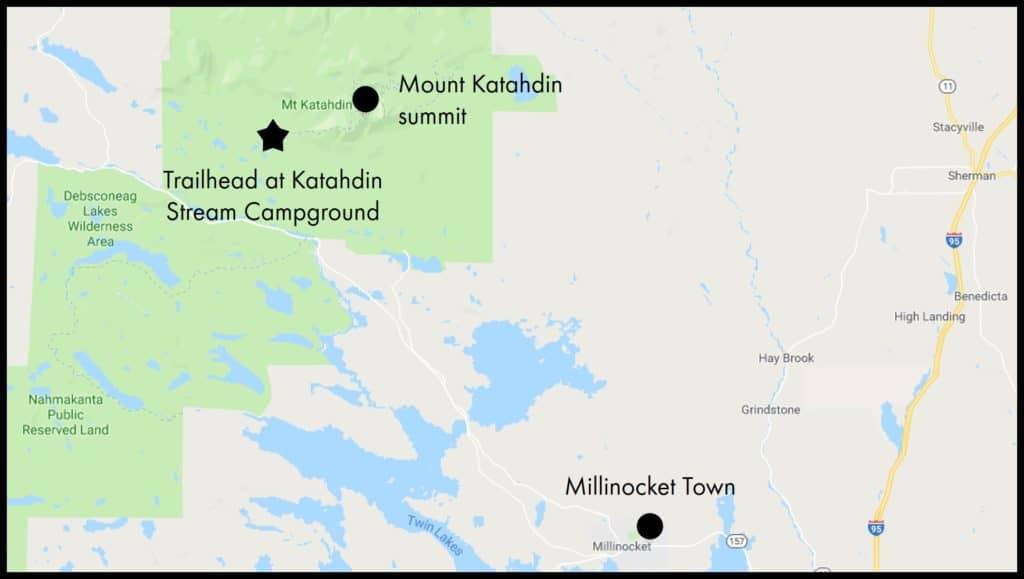
The most popular route for climbing Mount Katahdin is the Hunt Trail. It starts at the Katahdin Stream Campground.
The nearest town to the park is Millinocket. It is to the south-east of the park.
The park’s headquarters is in Millinocket. You can visit them for more information before your climb. There are also ranger stations at the trailheads in the park.
Baxter State Park Headquarters
64 Balsam Dr, Millinocket, ME 04462
Phone: (207) 723 9616
Operating hours: Mon to Fri, 8 am to 4 pm
Email: They don’t have an email address, but you can try contacting them over their Facebook page.
How Are The Views On Mount Katahdin?
Being the highest point in Maine, you get magnificent panoramic views on the summit.
Check out the summit views here:
You can also see the famous Knife Edge trail which is attempted only by the bravest among us.
When Is The Best Time To Climb Mount Katahdin?
Mount Katahdin can be climbed all year round.
The climbing seasons usually runs from mid-May to mid-October. The best time to climb Mount Katahdin will be from June to September. This is also the peak season where you will see more climbers.
But even in the summer, do not expect fair weather. Afternoon thunderstorms are common. It is recommended to start climbing very early in the morning to avoid getting caught in the rain.
From October to May, you will find more snow and ice in the mountains. Winter season is officially from 1 December to 31 March. Winter regulations are in place during this period. You will have to be prepared for winter climbing if you plan to go during this period.
Climbing Mount Katahdin in winter is more suited for experienced climbers. Mount Katahdin is already a challenging climb in summer. Expect tougher conditions in winter. There is more information on winter climbs in the section below.
Here’s a comparison of the conditions in summer and winter:
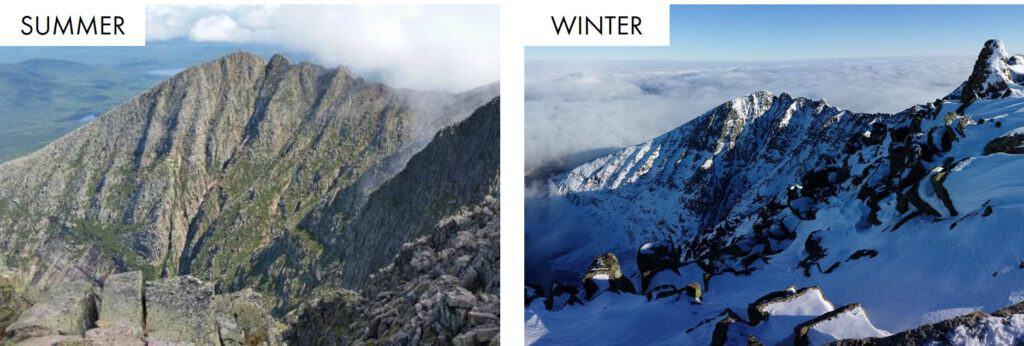
The conditions and temperatures vary year to year. Make sure you check the latest forecast before your climb.
What Are The Temperatures On Mount Katahdin?
Climbing Mount Katahdin is going to be chilly even in summer.
These are the average monthly temperatures on Mount Bierstadt. Strong winds on the trails might make it feel a lot colder.
| Low/ High (Fahrenheit) | Low/ High (Celsius) | |
| January | -17 / 6 | -27 / -15 |
| February | -15 / 10 | -26 / -12 |
| March | -4 / 20 | -20 / -7 |
| April | 11 / 32 | -12 / 0 |
| May | 23 / 47 | -5 /8 |
| June | 33 / 56 | 1 / 14 |
| July | 39 / 62 | 4 / 16 |
| August | 38 / 60 | 3 / 15 |
| September | 29 / 50 | -2 / 10 |
| October | 19 / 38 | -7 / 3 |
| November | 9 / 24 | -13 / -4 |
| December | -8 / 11 | -22 / -12 |
Save to Pinterest and add this to your bucket list!

How Long Does It Take To Climb Mount Katahdin?
The average time for a round trip up and down Mount Katadhin is about 8 to 12 hours.
This is for climbing Mount Katahdin in summer. Expect longer climbs in the winter.
Here are some factors to consider when estimating the time you need:
- Health and fitness levels: If you are used to strenuous workouts, you may even complete this climb in less than 8 hours. If you have not been exercising in a while, you might even need closer to 12 hours.
- Confidence: Going up Mount Katahdin is tiring, but the narrow ridges and exposure provide its own set of challenges. The fear of falling may slow you down considerably.
How Many Trails Are There?
There are 8 trails commonly listed for climbing Mount Katahdin. This can be deceiving. Some of these “trails” are just sections of the entire route from the trailhead to the summit.
These are the 8 trails:
- Abol: This is a complete trail from trailhead to the summit. It joins the same trail as the Hunt Trail for the last mile.
- Hunt: This is a complete trail from trailhead to the summit. This is the most popular trail.
- Helon Taylor: This is a partial trail leading from the trailhead to Pamola Peak (4,919 feet/ 1,500 meters).
- Knife Edge: This is a partial trail leading from Pamola Peak to the summit.
- Chimney Pond: This is a partial trail leading from the trailhead to Chimney Pond.
- Cathedral: This is a partial trail leading from Chimney Pond to the summit.
- Saddle: This is a partial trail leading from Chimney Pond to the summit.
- Hamlin Ridge: This DOES NOT lead to the summit of Mount Katahdin. It is a partial trail leading from Chimney Pond to Hamlin Peak (4,756 feet/ 1,450 meters).
There is a Dudley Trail that is currently closed until further notice. It is a partial trail from Chimney Pond to Pamola Peak.
In a nutshell, there are currently 5 complete trails to the summit. They start from 3 different trailheads:
- Abol Trail
- Hunt Trail
- Helen Taylor + Knife Edge Trail
- Chimney Pond + Cathedral Trail
- Chimney Pond + Saddle Trail
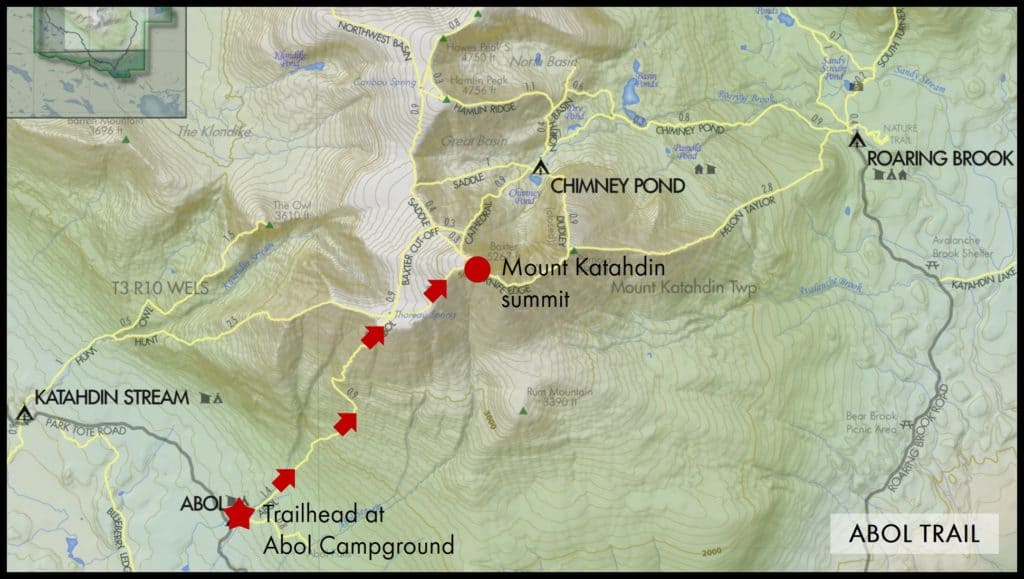
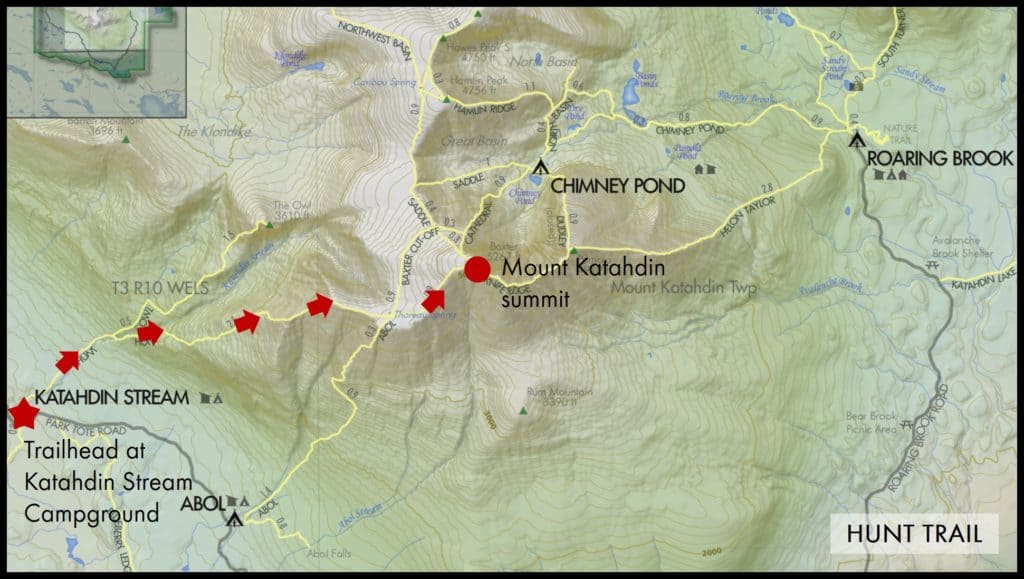
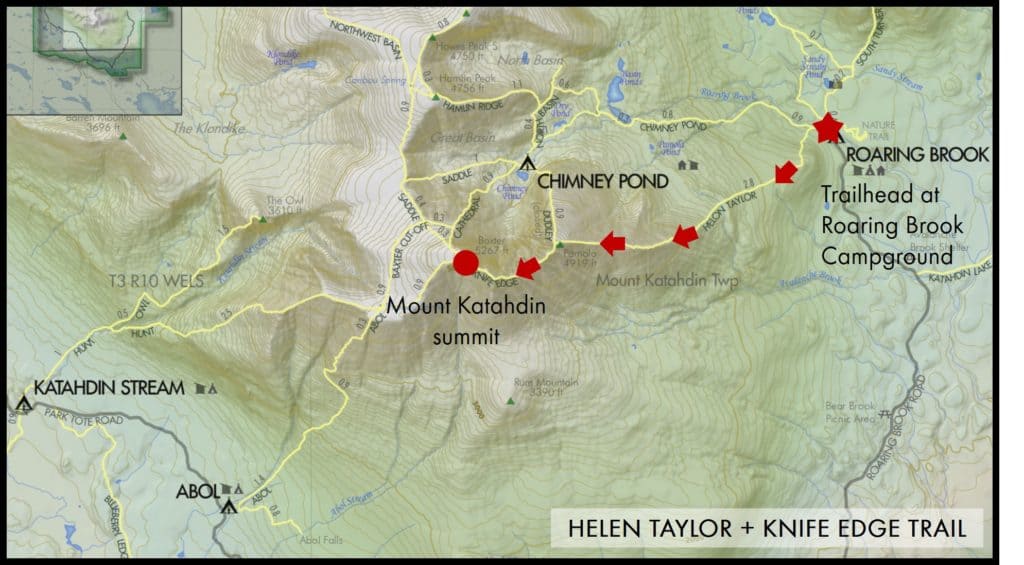
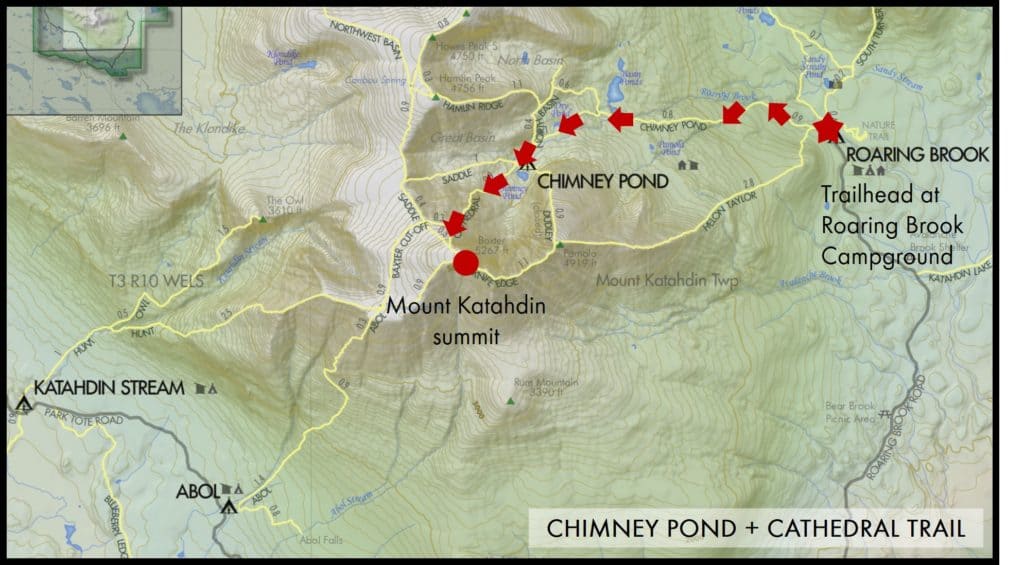

| One-way Distance | Elevation Gain | Yosemite Decimal System Rating | |
| Abol Trail | 3.8 mi/ 6.1 km* | 3,982 ft/ 1,214 m | Class 3 |
| Hunt Trail | 5.2 mi/ 8.4 km | 4,188 ft/ 1,277 m | Class 2 |
| Chimney Pond + Cathedral Trail | 5 mi/ 8 km | 3,778 ft/ 1,152 m | Class 3 |
| Chimney Pond + Saddle | 5.5 mi/ 8.9 km | 3,778 ft/ 1,152 m | Class 2 |
| Helen Taylor + Knife Edge | 4.3 mi/ 6.9 km | 3,778 ft/ 1,152 m | Class 3 |
*The Abol Trail is wrongly listed on the Baxtor State Park’s website as 4.4 mi.
How Do You Choose Which Trail To Take?
Among the 5 trails, I would go for the Hunt Trail or the Helen Talyor + Knife Edge Trail.
The Hunt Trail is the easiest and most popular route for climbing Mount Katahdin. The route is rated Class 2 under the Yosemite Decimal System (YDS). Read more about YDS here.
On the downside, the trail may be busier than the others. The Hunt Trail is also the last section of the Appalachian Trail. So besides the climbers going up to Mount Katahdin, expect this additional traffic.
| Insider tip: You can take a different trail going up and coming down. However, there is no transport provided by the park between the various trailheads. You will need to make your own arrangements. |
The Chimney + Saddle Trail is comparable to the Hunt Trail in terms of difficulty. But it is slightly longer.
The other 3 routes are tougher climbs.
If you are an adrenaline junkie or want to check an item off your bucket list, go for the Helen Taylor + Knife Edge Trail.
The Cathedral trail is just as tough as the Knife Edge. But the Knife Edge is a famous (or infamous) feature on Mount Katahdin.
Just watching the climb makes my palms sweat. Check it out here.
The Abol Trail the shortest and fastest route. This makes it a steep climb from start to finish. If you are short on time or would like a good workout, you can consider Abol.
| Hunt | Helen Taylor + Knife Edge | |
| Why take this trail? | This is the easiest and most popular route. It is less steep than Abol. | This is the adrenaline pumping route. The Knife Edge is a famous feature here. |
| Trailhead location (GPS coordinates) | Katahdin Stream Campground 45°53’13.3″N 68°59’58.4″W 45.887032, -68.999564 | Roaring Brook Campground 45°55’10.9″N 68°51’26.5″W 45.919695, -68.857348 |
| Trailhead elevation | 1,081 ft/ 329 m | 1,491 ft/ 454 m |
| Elevation gain | 4,188 ft/ 1,277 m | 3,778 ft/ 1,152 m |
| Distance | 5.2 mi / 8.4 km one-way 10.4 mi/ 16.8 km round-trip | 4.3 mi/ 6.9 km one-way 8.6 mi/ 13.8 km round-trip |
| Estimated completion time | 10 to 12 hours | 10 to 12 hours |
| YDS rating | Class 2 | Class 3 |
| Parking | About 27 lots for day hiking | About 36 lots for day hiking |
What To Expect On The Hunt Trail
The Hunt Trail is the last 5 miles of the 2,178 miles that thru-hikers need to walk to complete the Appalachian Trail. Expect to see more traffic on this trail.
The trail is well-marked, with paint on the rocks every 10 feet or so.
0 mile to 1 mile (0 km to 1.6 km)
1,081 feet to 1,447 feet (329 m to 441 m)
Starts from the trailhead at Katahdin Stream Campground. Fairly gentle hike along Katahdin Stream. At the 1 mile (1.6 km) mark, you will cross the Katahdin Stream. You will see the Katahdin Stream Falls.
1 mile to 3 mile (1.6 km to 4.8 km)
1,447 feet to 3,753 feet (441 m to 1,144 m)
The trail becomes steeper and more strenuous.
3 mile to 3.8 mile (4.8 km to 6.1 km)
3,753 feet to 4,577 feet (1,144 m to 1,395 m)
A long stretch of scrambling.
About the 3rd mile (4.8 km) mark, you will pass the treeline. You need to scramble across some huge rocks. There are some iron rungs in place to help with the climb.
At the 3.3 mile (5.3 km) mark, you will reach a narrow ridge. It is not as narrow as the Knife Edge but it is exposed at certain areas. The ridge is about 0.5 miles long (0.8 km).
3.8 to 5.2 mile (6.1 km to 8.4 km)
4,577 feet to 5,269 feet (1,395 m to 1,606 m)
The trail flattens after the ridge.
At the 4.2 mile (6.8 km) mark, you will see the Abol Trail joining in from the right. On the left is the Baxter Peak Spur Trail. Continue straight to stay on the Hunt Trail.
This last mile to the summit becomes less steep.
5.2 mile (8.4 km)
5,269 feet (1,606 m)
You are at the summit!!
What To Expect On The Helen Taylor + Knife Edge Trail
0 mile to 0.25 mile (0 km to 0.4 km)
1,491 feet to 1,696 feet (454 m to 517 m)
Starts from the trailhead at Roaring Brook Campground. This is the same trail for the Helen Taylor Trail and the Chimney Pond Trail.
0.25 mile to 0.5 mile (0.4 km to 0.8 km)
1,696 feet to 1,959 feet (517 m to 597 m)
At the 0.25 mile (0.4 km) mark, the trail splits. Go left to stay on the Helen Taylor Trail. Going straight will take you on the Chimney Pond Trail.
The trail is quite steep here.
0.5 mile to 1.6 mile (0.8 km to 2.6 km)
1,959 feet to 2,844 feet (597 m to 867 m)
This is the flattest section of the trail. At the 1.3 mile (2.1 km) mark, you will cross a stream.
1.6 mile to 3.2 mile (2.6 km to 5.1 km)
2,844 feet to 4,919 feet (867 m to 1,500 m)
You will reach a narrow ridge with exposure on both sides. This is a long ridge which continues for 1.6 miles (2.6 km) to Pamola Peak.
3.2 mile to 4.3 mile (5.1 km to 6.9 km)
4,919 feet to 5,269 feet (1,500 m to 1,606 m)
You have reached Pamola Peak!
On the left, you will see the Knife Edge Trail leading to Mount Katahdin summit.
On the right is the Dudley Trail which is currently closed. It used to be a 1 mile (1.6 km) trail that connects Pamola Peak to the Chimney Pond Campground.
The Knife Edge is a narrow ridge which continues for 1.1 mile (1.8 km). That is over a mile long of scrambling over rocks, with deadly falls on either side.
Remember that if you are taking the same route back for a round trip, you will need to cross the Knife Edge twice.
| Important: The narrow ridges on Helen Taylor and Knife Edge MUST NOT be attempted in bad weather. Strong winds can blow you right off the ridge. Climbers have fallen and died in the past. |
A video speaks a million words. If you have not seen the Knife Edge video above, check it out.
4.3 mile (6.9 km)
5,269 feet (1,606 m)
You are at the summit!!
What Time Should You Start Climbing (Itineraries)
Before climbing Mount Katahdin, there are a couple of things to consider:
- If you want to catch the sunrise on the summit, you will need to camp in the park the night before. You will start climbing in the wee morning.
- If you planing to do a day hike, you need to make a reservation for a parking spot (more information below). Even with the reseravtion, your parking spot will only be held for you until 7 am.
- Afternoon thunderstorm is common in the summer. The rocks become very slippery and it is dangerous on all the trails when it rains. The trails are exposed and there’s no shelter. If rain is expected, you should aim to complete your climb before that.
- If you are starting out later in the day, do take note of the sunset timings. Bring along your headlamp to avoid getting caught in the dark. The sunsets are quite late in the summer — about 7.30 pm to 8.30 pm. But keep track of your pace and the time you need to make the descent.
Itinerary 1:
- To catch the sunrise or avoid afternoon thunderstorms
- Assuming a 10 hour round trip
| 12 mn to 1 pm | Begin climb |
| 5 am to 6 am | Reach the summit |
| June: 4.40 am to 4.50 am July: 4.45 am to 5.15 am Aug: 5.15 am to 5.55 am Sep: 5.50 am to 6.30 am | Sunrise |
| 6 am — 7.30 am | Begin descent |
| 11 am — 12.30 pm | Return to the starting point |
Itinerary 2:
- Day trip
- Assuming a 10 hour round trip
| 6 am | Begin climb |
| 11 am | Reach the summit |
| 11 am — 12 pm | Lunch + take photos |
| 12 pm | Begin descent |
| 5 pm | Reach the starting point |
Do You Need A Permit? Are There Any Fees?
There are no permits for climbing Mount Katahdin, but the number of climbers is controlled by the availability of the camping and parking spots.
There are 3 types of fees that you may have to pay for:
- Park entrance fees (purchase it online here): $15 per vehicle. This is for non-Maine residents. You can purchase it online here or at the gatehouses during entry.
- Parking fees (reserve a spot online here): $5 per vehicle. This is for climbers doing a day hike (i.e. not camping overnight). See more information in the section below.
- Camping fees (reserve a campground here): If you are camping overnight, you will not need to get a parking reservation.
In a nutshell:
- If you are a Maine resident and camping overnight: You need to pay the camping fees.
- If you are a Maine resident and doing a day hike: You will need to pay the parking fees.
- If you are NOT a Maine resident and camping overnight: You need to pay the entrance fees and camping fees.
- If you are NOT a Maine resident and doing a day hike: You will need to pay the entrance fees and parking fees.
| Important: You must sign in at the campgrounds at the respective trailheads before your climb. You need to provide your name, the route you are taking, your time of departure, and expected time of return. This helps the rangers to keep track of the climbers and arrange for rescue in emergencies. |
What To Wear
Here’s what to wear for climbing Mount Katahdin:
- Hat/ cap: You will be spending a lot of time directly under the sun with no trees for shelter.
- Sunglasses
- Inner layer
- Sweat-wicking shirt
- Trek pants or gym pants
- Insulating layer
- A jacket for keeping warm — can be fleece or down etc
- If you like to keep your leg warms, you can also consider bringing another layer
- Waterproof layer
- The weather is unpredictable in the mountains. Always pack a set of waterproof jacket and pants for your climb.
| Insider tip: Find out how to choose the right layers for your climb here. |
- Hiking socks
- Hiking boots: This is NOT a trail that you should climb with trail runners. Trail runners will provide enough traction and support for the rocky terrains. A mid-height hiking boot is preferred here. This is a job for my trusty Merrell Moab 2 — check out my review here.
| Insider tip: You may not need your insulating or waterproof layers at the start of your climb. Pack them at the top of your backpack for easy access when you need them. Keep them in waterproof bags in case of rain. Keep an extra set of clothes in your car. You can change out of your wet or sweaty clothes after your climb. |
If you are climbing outside of the June to September period, you will expect more snow in the mountains. Depending on the actual conditions, you will also need:
- Insulated footwear: You need boots with proper insulation for the weather
- Gaitors: These prevent snow or ice from getting into your boots.
- Crampons: You will need these for winter climbing.
Packing List And What To Bring
Here’s what to bring for climbing Mount Katahdin:
- Backpack: You will need a 25L to 30L backpack. Use a proper hiking backpack with a hip belt and padding on the shoulder straps. This will make your hike a much more comfortable one. You can see a review of my favorite 30L backpack here.
- Extra set of clothes (you can leave them in the car)
- Hiking stick: Not particularly useful here. You need to use your hands on the steeper of the trails. But it may be useful along certain sections when you are coming down from the summit. It helps with your balance and reduces the impact on your knees. Check out these tips on climbing with painful or injured knees.
- Headlamp: For climbing in the dark. Do not rely on a torchlight or your phone. You should keep your hands free during the climb.
- Water: Depending on your needs, I recommend at least 0.5 to 0.8 gallons (2 to 3 liters) of water.
- Food: Depending on the duration of your climb, you will need to pack some snacks or even a proper meal or two. Get some ideas on what food and snacks you can pack for your trip. You need to bring more food if you are climbing in winter.
- First aid supplies: I always have these items with me
- Plasters
- Eyedrops: In case sand or debris get into your eyes
- Medication for headaches, nausea, stomach upset, altitude sickness etc
- Insect repellent, ointments for insect bites
- Nail clippers: For some reason, my fingernails tend to chip or crack in the mountains
- Trash bags: There are no trash bins in the mountains. Everything that you carry in with you has to come out with you.
- Camera: You don’t want to be climbing to the top of Colorado and not have something to capture the amazing views! This is my favorite camera that’s easy to bring on a trail.
- Miscellaneous
- Sunblock
- Lip balm
- Tissue, napkins, toilet paper
- Hand sanitizer
- Whistle: Useful for an emergency, especially if you are climbing alone.
- Hand and foot warmers: Useful if you do not do well in cold temperatures.
If you are camping overnight, you will also need:
- Sleeping bag: Make sure it is sufficiently insulated for the weather.
- Sleeping aids: If you are a light sleeper, it helps to wear an eye mask or earplugs when you sleep.
- Bear canister: This is to keep food away from bears and other wildlife. You will need to hang the canister food from tree limbs 12 feet off the ground, 6 feet from the tree’s trunk, and 6 feet below the supporting limb.
- Pocketknife: Useful to cut ropes for hanging the bear canisters or for other camping needs.
For winter climbs, you will need:
- Ice axe: Ice axe is required when crossing snowfields. They are used to cut steps in hard snow or ice. They are also used for self-arrest (i.e. stopping your fall). Learn more about self-arrests and check out my favorite ice axe here.
- Avalanche safety gear such as snow shovel and snow probe.
| Insider tips: – To protect your stuff from the rain, pack them in small waterproof bags in your backpack. At a minimum, make sure you waterproof your electronics such as phones and cameras. I like to use ziplock bags for this. – Ziplock bags also double up as spill proof trash bags. These are perfect for storing food or other messy waste. |
How To Get To The Trailhead?
There are 2 entrances to the park — the Matagamon Gate at the north and Togue Pond Gate at the south.
The Togue Pond Gate is closer to the trails and probably the more commonly used entrance.
Togue Pond Gatehouse
Address: Baxter Park Road, Millinocket, ME 04462
Coordinates:
45°49’40.9″N 68°53’23.4″W
45.828032, -68.889842
Matagamon Gate
Address: Grand Lake Road, Patten, ME 04765, USA
Coordinates:
46°09’17.7″N 68°48’20.1″W
46.154918, -68.805589
.
There are 3 trailheads to the summit of Mount Katahdin.
Turning left after the Togue Pond Gatehouse will take you to the trailheads at Katahdin Stream Campground and Abol Campground.
Turning right after the Togue Pond Gatehouse will take you to the trailhead at Roaring Brooks Campground.

Trailhead at Katahdin Stream Campground
This trailhead is for the Hunt Trail. There is a gravel road leading up to the trailhead. This can be accessed by all cars.
Trailhead at Abol Campground
This trailhead is for the Abol Trail. There is a gravel road leading up to the trailhead. This can be accessed by all cars.
Trailhead at Roaring Brooks Campground
This trailhead is for the remaining 3 trails — Helen Taylor + Knife Edge Trail, Chimney Pond + Cathedral Trail and Chimney Pond + Saddle Trail. There is a gravel road leading up to the trailhead. This can be accessed by all cars.
| Insider tip: The roads in the park are not plowed in winter. Check the Winter Use Map on the park’s website for more information. |
Parking Lots — Reservations and Locations
| Insider tip: If you are using Google Maps or other navigation on your phone, download an offline map. This is in case you lose cell reception. |
The parking at the 3 trailheads at within the campgrounds.
There are separate parking areas for climbers who are camping overnight and those who are doing the day hike.
| Important: Vehicles over 9 feet (2.7 meters) high, 7 feet (2.1 meters) wide, or 22 feet (6.7 meters) long for a single vehicle or 44 feet (13.4 meters) long for combined units cannot enter the park without a special use permit or other authorization. |
Parking at Katahdin Stream Campground
There are about 27 lots available for reservation.
Coordinates:
45°53’12.9″N 68°59’57.4″W
45.886902, -68.999285
Parking at Abol Campground
There are about 16 lots available for reservation.
Coordinates:
45°52’25.2″N 68°57’50.5″W
45.873677, -68.964022
Parking at Roaring Brooks Campground
There are about 36 lots available for reservation.
Coordinates:
45°55’11.1″N 68°51’25.9″W
45.919752, -68.857182
Are Reservations Compulsory?
The reservations are only carried out from June to October. Outside this period, parking is usually plentiful and no reservation is required.
From June to October, reservation is strongly encouraged. If you do not make a reservation, you may be turned away at the park entrance if there are no extra lots.
How Do Reservations Work?
The reservation fee is $5 for one vehicle. You can only make up to 3 reservations per calendar month.
You can make the reservation online or by calling the Reservation office.
| Online reservation | Reservation Office Phone: 207-723-5140 Operating hours: Summer: Mon to Sun, 8 am to 4 pm Winter: Mon to Fri, 8 am to 4 pm |
For online reservations, you will need to sign up for an account and register your vehicle before you can make the booking.
| Important: Your parking reservation is not held for you indefinitely. You have to be at your spot by 7 am or your lot will be given up to others. |
When Can You Make The Reservation?
For Maine residents, you can make a reservation for the summer after 1 April. You can select any day for that summer.
For non-Maine residents, you can only make a reservation up to 2 weeks before your hike.
What Happens If You Cannot Get A Reservation?
You can try your luck at the Togue Pond Gatehouse. At 6 am, any unreserved lots will be filled up at a first come, first served basis. At 7 am, if there is any no show for any reserved lots, they will also be given out at a first come, first served basis.
You cannot park along the roadside.
Or you can consider spending a night at one of the campgrounds at the trailheads. You don’t need a parking reservation if you are camping. However, the campgrounds tend to fill up very quickly as well.
Camping And Accommodation
You can only camp at the authorized campgrounds.
There are campgrounds at the 3 trailheads.
Abol Campground
- 12 lean-to shelters: maximum capacity of 4 each
- 8 6-man tents
- 1 4-man tent
Katahdin Stream Campground
- 12 lean-to shelters: maximum capacity of 4 to 5 each
- 9 6-man tents
- 1 4-man tent
- 3 group areas: maximum capacity of 12 to 23 each
Roaring Brooks Campground
- 9 lean-to shelters: maximum capacity of 4 to 6 each
- 6 6-man tents
- 4 4-man tent
- 3 group areas: maximum capacity of 14 each
- 10 bunkhouses: maximum capacity of 1 each
How Do You Make A Reservation?
You can make the reservation online or through the Reservation Office (207-723-5140). You can check their availability here.
| Important: – Check in time is after 1 pm. At the latest, you have to arrive at the Togue Pond Gatehouse before 8.30 pm on the night of your camping. – Check-out time is 11 am. – The maximum capacity of your campsite is strictly enforced. – You cannot bring any pets. – You cannot bring outside firewood. |
When Can You Make The Reservation?
You can make the reservation anytime. Make your bookings early! The campsites are usually booked months in advance.
What Happens If You Cannot Get A Reservation?
There are other campgrounds within the park. You can see the full list here. If you are not camping near the trailheads, check with the Reservation Office (207-723-5140) for the parking arrangement for your climb.
Climbing Mount Katahdin In Winter: A Recap And Important Things to Note
Check the Baxtor State Park website for the latest winter regulations and resources.
- Avalanches are possible. Check the latest forecast here.
- Winter climbing is suited for more experienced climbers. If you are a beginner, make sure you are familiar with the winter gear you need to use. Also, make sure you climb with someone more experienced.
- Besides the 5 main trails, there are also technical ice climbing routes available. You can check the route and distances on the Winter Distance Table here. Expect longer climb times in the winter.
- You will need to wear additional insulating layers for your climb.
- You will need gaiters, snowshoes and even an ice axe. You may also need avalanche safety gear such as a snow shovel and snow probe. Learn how to use these pieces of equipment properly before your climb.
- You need to bring extra food.
- If you are camping, make sure your sleeping bag has sufficient insulation.
- Headlamp or torchlight is compulsory in winter. The daylight hours are shorter in winter.
- The trails may be hidden by the snow or ice. Make sure you are familiar with route finding (i.e. how to read a map and use a compass or GPS).
- There are a lot fewer climbers in winter. Do not expect to bump into other climbers if you are lost or need assistance.
What Are The Dangers Of Climbing Mount Katahdin?
Although Mount Katahdin is not a very high mountain, there are still many dangers and risks:
- Falls: A high risk on Mount Katahdin. All the trails leading to the summit involves scrambling over rocks and boulders. Loose rocks and wet rocks greatly increase your chances of falling. When crossing the narrow ridges, strong winds can blow you off the edge.
- Hypothermia: A serious risk in winter or if you get caught in the afternoon thunderstorms!
- Getting lost: A bigger risk on the less popular routes where the trails are less obvious.
- Dehydration: It is a long day climb. Do not underestimate how much water you need.
- Avalanches: A risk in winter.
These are just a few of the hazards you may encounter. To find out more about these dangers and how to prevent them, check out this article.
Other Important Information
- You can only have a maximum of 12 people in one hiking group.
- No children under the age of 6 is allowed above the treelines on the trails.
- No pets are allowed in the park.
You can learn more about Baxtor State Park’s Rules here.
This is Part 3 of 6 of the Mountains To Climb In The US Mini-series:
Part 1: Highest Mountains To Climb In The US For Beginners
Part 2: Ultimate Guide To Climbing Mount Elbert
Part 3: Ultimate Guide To Climbing Mount Katahdin
Part 4: Ultimate Guide To Climbing Mount Bierstadt
Part 5: Ultimate Guide To Climbing South Sister
Part 6: Ultimate Guide To Climbing Mount Borah
Save to Pinterest and add this to your bucket list!

